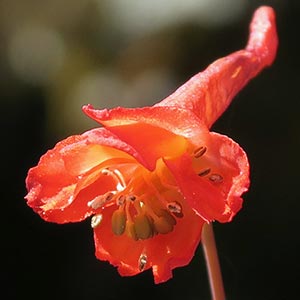Delphinium nudicaule
Delphinium gypsophilum
canyon delphinium, canyon larkspur, orange larkspur, red larkspur, red or orange larkspur, scarlet larkspur
gypsum-loving larkspur, Pinoche Creek larkspur
(15-)20-50(-125) cm;
base reddish, glabrous.
(30-)60-100(-150) cm;
base usually reddish, glabrous, glaucous.
blade round to pentagonal, 2-6 × 3-10 cm; ultimate lobes 3-12, width 5-40 mm (basal), 2-20 mm (cauline).
blade round to pentagonal, 1.5-6 × 2-12 cm, nearly glabrous; ultimate lobes 3-12, width 3-24 mm (basal), 1-8 mm (cauline).
5-20(-69)-flowered;
pedicel (1.5-)2-6(-8) cm, glabrous to glandular-pubescent;
bracteoles 14-20(-30) mm from flowers, green to red, linear, 2-4(-9) mm, glabrous to puberulent.
15-30(-64)-flowered, cylindric;
pedicel spreading, (0.5-)1.5-3.5 cm, glabrous;
bracteoles 2-6 mm from flowers, green, linear, 2-5 mm, glabrous.
sepals scarlet to reddish orange, rarely dull yellow, glabrous, lateral sepals forward-pointing to form pseudotube, (6-)8-13(-16) × 3-6 mm, spurs straight, slightly ascending, (12-)18-27(-34) mm;
lower petal blades elevated, exposing stamens, 2-3 mm, clefts 0.5-1 mm;
hairs sparse, evenly dispersed, yellow.
sepals rarely reflexed, white to pink, nearly glabrous, lateral sepals spreading, 7-19 × 3-10 mm, spurs straight to upcurved, ascending 30-45° above horizontal, 7-15 mm;
lower petal blades elevated, exposing stamens, 3-8 mm, clefts 1-4 mm;
hairs centered near base of cleft, ± evenly distributed, white.
13-26 mm, 3.5-4.5 times longer than wide, glabrous.
9-18 mm, 2.5-3.2 times longer than wide, puberulent.
unwinged or sometimes slightly wing-margined;
seed coat cells with surfaces smooth.
seed coat cells brick-shaped, cell margins undulate, surfaces roughened.
= 16.
Delphinium nudicaule
Delphinium gypsophilum
Delphinium nudicaule hybridizes with most other taxa of Delphinium that it encounters. Apparent hybrids involving D. nudicaule, and seen by the author (either afield or as specimens), include D. andersonii, D. antoninum, D. decorum, D. luteum, D. nuttallianum, D. patens, and D. trolliifolium. In addition, garden-grown plants have been hybridized with D. cardinale, D. elatum, D. menziesii, D. parishii, D. penardii, D. tatsienense Franchet, D. triste Fischer ex de Candolle, and D. uliginosum; D. nudicaule does not naturally occur with these species. Delphinium nudicaule is one of the earliest larkspurs to flower in any given locality. Douglas's type collection of D. nudicaule represents plants (synonyms D. sarcophyllum Hooker & Arnott and D. peltatum Hooker, an invalid name) grown under very moist conditions, probably quite near the ocean. The type specimen of D. armeniacum A. Heller represents plants grown under unusually dry conditions.
The Mendocino Indians consider Delphinium nudicaule a narcotic (D. E. Moerman 1986).
(Discussion copyrighted by Flora of North America; reprinted with permission.)
Subspecies 2 (2 in the flora).
Delphinium gypsophilum is sometimes confused with D. hesperium subsp. pallescens, D. recurvatum, and the white-flowered phases of D. hansenii subsp. kernense. The echinate seeds and long-haired petioles of D. hansenii immediately distinguish it from D. gypsophilum, which has neither.
Delphinium gypsophilum is related, and similar in many respects, to D. recurvatum. The two may be distinguished morphologically by their sepals. Delphinium recurvatum has reflexed, blue sepals; those of D. gypsophilum are spreading and white, although they may change to light blue when dry. Plants of D. recurvatum normally are less than 60 cm; those of D. gypsophilum are usually more than 60 cm. Ecologically, D. recurvatum occupies level ground among shrubs, typically in alkaline valley bottoms; D. gypsophilum is found on well-drained hillsides among grasses and in chaparral and oak woodland.
From Delphinium hesperium subsp. pallescens, specimens of D. gypsophilum may be separated by their much more finely dissected leaves, with less surface area, stem base usually reddish, stems frequently glaucous proximally, undulate margins of seed coat cells, and absence of striations in stem base of dried specimens. In contrast, D. hesperium subsp. pallescens has leaves less dissected, with greater surface area, stem base rarely reddish, stem not glaucous proximally, seed coat cells with straight margins, and striations present on the proximal stem of dried specimens.
(Discussion copyrighted by Flora of North America; reprinted with permission.)
1. Lower petals 5–8 mm; lateral sepals 10 mm or more; pedicel usually more than 1 cm apart. | subsp. gypsophilum |
1. Lower petals 3–5 mm; lateral sepals 10 mm or less; pedicel usually less than 1 cm apart. | subsp. parviflorum |


